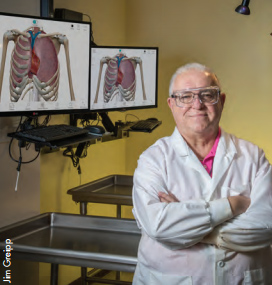
Dennis DePace, PhD, Senior Associate Dean for Medical Student Admissions; Associate Professor, Neurobiology & Anatomy
Are medical students at Drexel doing full cadaver dissection today?
Yes. In the past, anatomy was a selfcontained unit taught during the first semester in most medical schools. At Drexel, the course runs throughout the academic year using full cadaver dissection. For example, in the Interdisciplinary Foundations of Medicine curriculum, as we move from one module to another, students study anatomy during the appropriate modules. The first module where they study anatomy in earnest is muscle weakness. In that module, they’re learning about the musculoskeletal system, so we teach them the anatomy of the back and upper limbs. The next module where they study anatomy is chest pain, and we teach the anatomy of the thorax, lungs, pleura and heart.
Was full cadaver dissection ever considered unnecessary?
When I was a graduate student at the University of Buffalo in 1969-70, the anatomy professor was told he had to cut his course by 10 percent. His approach was to let the course continue as it was, and when they reached the 10 percent point, he ended the course. When I was there, the course ended when they got to the lower extremity. So those students graduated without knowing anything about the body below the knee. It was the same for a lot of other schools as well. Many cut their anatomy curriculum to bare bones, and had prosections done ahead of time for the students to study when they came to the lab.
Prior to my joining Hahnemann University in 1974, the anatomy department was chaired by a geneticist. Cell biology was emphasized, and anatomy was really downplayed. When Dr. Peter Amenta became chair of anatomy, he was charged with bringing anatomy back into the curriculum. When I joined the faculty, we had a full gross anatomy course. The students still do the dissection work themselves. We have a staff member who dissects a cadaver in concert with the students so they can use it as a reference.
What role does technology play in teaching gross anatomy today?
Two years ago, we re-outfitted the anatomy lab so every station, every table, every group of students in the lab now has a high-definition TV monitor and a mini computer. They can link to the Internet from the lab computer to search for images and information related to their dissection.
We subscribe to an electronic dissection manual for the students. I can go on the publisher’s website, edit the dissector and change the order of things to make it match what we want our students to do.
We also installed two new software programs on our computers in the lab. Visible Body 3D enables students to bring up a 3D model of a human, which they can rotate. They can also remove structures to see structures that are deeper, and remove muscles to find the vessels underneath. The Muscle Premium program demonstrates the actions of muscles through animation.
How do the students benefit most from gross anatomy?
The anatomy experience introduces them to a variety of people in the lab. We have a very good willed-cadaver program here in Pennsylvania. When I was a student at the University of Buffalo, most of the bodies came from the city morgue. They were largely indigent people and most were male. Here, we have a variety of cadavers both male and female. Some of the patients who are now cadavers may have died from cancer and were very wasted at the end of their lives. Some people may have been very obese. In the course of dissection, students may see coronary bypass surgery, knee replacements, hip replacements, cardiac pacemakers, and other medical appliances.
We also use our anatomy experience as a tool for professionalism. Students evaluate each other three times during the course in terms of preparedness and how well they work with others.
What is expected of students in terms of professionalism?
I tell the students that each group is assigned a cadaver, and each person’s responsibility is to make the best possible use of the cadaver in dissecting to honor the person who made this contribution to their education. The students are also responsible to do their best work because although an individual cadaver belongs to the group that dissects it, all the cadavers belong to the class; the entire class has to study from all the cadavers for the laboratory exams.